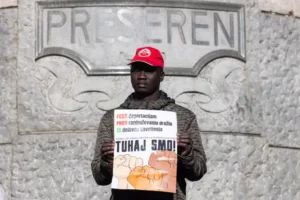The so-called “erased” affair is presented by the Slovenian left as a black stain on Slovenian identity, when in fact, it indirectly shows the opposite: it is the brightest spot of Slovenian identity, because Slovenians have always been ready to accept those true refugees in need of help. At the same time, immigration tables show that there are far more foreigners in Slovenia than the official authorities are prepared to admit.
Matjaž Štajner, a user of the X social network, has pointed out what the case of the erased really shows: the fact that our parents peacefully accepted 223,698 foreigners at the time when Slovenia won its independence in 1991, and then, secondly, that our parents accepted an even larger number of immigrants to independent Slovenia in 2002, when there was a second mass migration of people from the territory of the former Yugoslavia.
In 2002, the legal terms “Slovenian” and “foreigner” were completely redefined, and an additional 108,975 foreigners were granted citizenship. Of these, 25,671 were already officially “erased”, and an additional 83,304 were granted citizenship who had not even managed to be erased in 1992 because they had not managed to move to Slovenia by the time of independence in 1991. Slovenia thus experienced two waves of alleged complete assimilation of foreigners into Slovenia, when suddenly everyone became “Slovenian citizens”.
Administrative Units Fail to Implement the Aliens Act
As Štajner pointed out, the Aliens Act should finally guarantee Slovenians that Slovenian citizenship rights will never again be simply handed out. Rigid mechanisms and rules were put in place as to when a foreigner could even be granted temporary and permanent residence, but the law has become completely irrelevant because it is not actually implemented by the lower bureaucracy. The administrative units – which are in reality only branches of the Ministry of Public Administration in the local areas – do not implement the law in so far as it imposes on resident foreigners the obligation to provide sufficient resources for the duration of their stay, so social financial assistance is activated for foreigners – even though the Aliens Act stipulates that foreigners are not entitled to it, or that their income for the duration of their stay should be above the census for financial assistance, as they risk deportation if they do not achieve that.
How many foreign “visitors” are there?
Currently, the number of new foreigners with papers who have legally arrived in Slovenia is 234,070, but this figure does not include those who are merely “visiting” due to the open borders. As the registers on such “visitors” are not kept, the number of visitors is unknown, but from history we can assume that it is around 100,000 people (so the number of “foreigners by citizenship” in Slovenia could also be around 334,000, or “foreigners by nationality” around 628,000). Štajner pointed out that those visiting Slovenia could prove that they are staying in Slovenia, similar to how the erased once did it, and thus be entitled to citizenship. For this reason, he
estimates that the official government statistics grossly underestimate the proportion of foreigners, which is said to be ten percent, while he himself estimates that the proportion has already exceeded 25 percent of all those living in Slovenia. In his view, in 2024, there were only 1.6 million indigenous Slovenians left, and as many as 528,000 “foreigners by nationality” (so-called “visitors”).

Migrant tourism
The migrant tourism that Štajner highlighted in his post is mainly due to the fact that Slovenia is used by foreigners – mainly people from the former Yugoslavia – for social tourism through the institution of family reunification, where so-called “gastarbeiters” bring their wives and children to Slovenia after a certain period of stay, and then have a few more children in Slovenia, while their wives stay at home as housewives, receiving the fabulous incomes for families with several children. It is true that the Administrative Units often do not take into account the subsistence census, but there is another problem: the census is set too low. Even when a foreigner does meet it (sometimes by temporarily transferring funds from foreign accounts with the help of relatives), it is far from enough to support families of four, five or even six. In the end, of course, they count on receiving social assistance on top of their salary (which is officially the living wage).
The solution would be extremely simple, and it is already in use in several European countries: the instrument of family reunification under the Aliens Act would have a simple addendum: the members brought by the foreigner to Slovenia are the sole responsibility of the said foreigner, and the Slovenian state is not responsible for them, even once they have obtained permanent residence permits. Suddenly, Slovenia would no longer be a popular destination, either for Middle Eastern migrants or for the poor inhabitants of the former Republic of Yugoslavia.
I. K.


